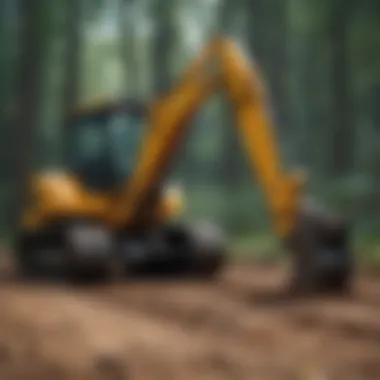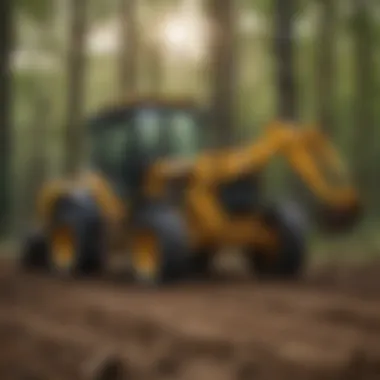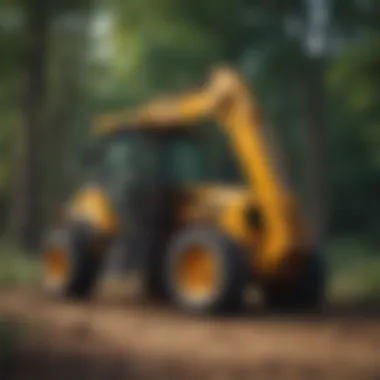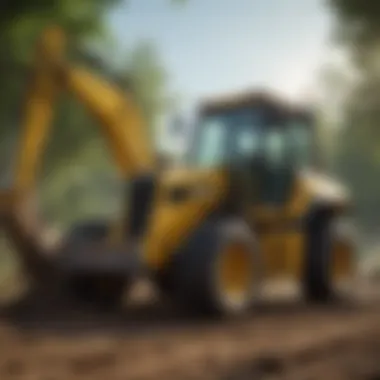Understanding Woods Backhoe Parts: A Comprehensive Overview


Intro
Woods backhoes play a crucial role in both agriculture and construction. Understanding their parts is essential for optimal performance and longevity. Each component serves a specific function, contributing to the overall efficiency of the machinery. This article will explore the key features of Woods backhoe parts, delve into their significance, and offer insights that can help users maintain and repair these machines effectively.
Key Concepts and Terminology
Definition of Terms
To grasp the intricacies of Woods backhoe parts, one must become familiar with certain terminology:
- Bucket: The primary attachment used for digging and lifting material.
- Boom: The arm that connects the bucket to the backhoe frame, allowing for extendable reach.
- Dipper: Also known as the stick, it connects the bucket to the boom and provides additional reach.
- Stabilizers: Legs that extend from the backhoe to provide stability during operation.
- Hydraulic System: A system that uses fluid pressure to power the movements of the backhoe components.
Overview of Relevant Practices
Understanding the parts is not just about their definitions. It requires knowledge of how they interact and are maintained. Regular inspection and proper lubrication are critical practices. Users should develop a routine that includes checking hydraulic fluid levels, inspecting hoses for leaks, and ensuring that joints are well-greased. Such practices lead to a longer lifespan for the equipment and better performance.
Current Trends and Innovations
Latest Research and Developments
The field of backhoe design has seen various advancements. Innovations in hydraulic systems have allowed for improved efficiency and power. Research indicates that new materials are being used to enhance the durability of parts, which is essential for heavy-duty applications
Emerging Technologies and Tools
Modern technologies, such as GPS and telematics, are becoming common in backhoe operation. These tools help operators increase accuracy and reduce operational costs. Advanced control systems also allow for better maneuverability and precision in handling tasks, whether digging or lifting.
Practical Applications
Step-by-Step Guides
Maintaining a Woods backhoe does not need to be intimidating when broken down into manageable steps:
- Inspect the Hydraulic System: Check for leaks and ensure fluid levels are adequate.
- Examine the Bucket and Dipper: Look for signs of wear or damage. Replace if necessary.
- Test Stabilizers: Make sure they deploy and retract correctly. Repair any issues.
- Maintenance of the Boom: Ensure that all joints are properly lubricated.
Troubleshooting Common Issues
When facing problems, it is important to understand what could be affecting performance:
- Loss of Power: Check the hydraulic fluid.
- Ineffective Digging: Inspect the bucket for damage or wear.
- Unstable Operation: Assess the stabilizers; they might need adjustments or repairs.
Regular maintenance and understanding parts are essential for the optimal performance of Woods backhoes.
Foreword to Woods Backhoes
Woods backhoes represent a crucial element in the toolbox of modern agriculture and construction machinery. Understanding their design and functionality offers significant benefits to operators and decision-makers in these fields. This introduction will elaborate on the historical context and relevance of Woods backhoes in current practices. Through exploring their origin and development, one gains insight into their importance in the industry.
History and Evolution
Woods Equipment Company has a rich history that dates back several decades. Founded in the 1940s, the company initially focused on developing attachments for tractors. As demand for more versatile machinery grew, the company expanded into manufacturing backhoes.
The early models of Woods backhoes were manually operated, relying on the physical strength of the user. Over time, advancements in hydraulic technology transformed backhoes into the powerful machines we see today. This evolution has not only improved efficiency but also increased safety for operators. Modern Woods backhoes now feature significant enhancements such as improved hydraulic systems, durable materials, and ergonomic controls, making them user-friendly and highly efficient.
Importance in Agriculture and Construction
Woods backhoes play an important role in both agriculture and construction sectors. In agriculture, they assist in digging trenches, planting trees, and moving soil. The accurate positioning of the boom and bucket allows for precise work, crucial in maintaining productivity on farms.
In construction, Woods backhoes are used for various tasks, like excavating foundations and clearing sites. Their ability to easily switch attachments enhances their functionality, adapting them to different projects. They help streamline operations, allowing for faster completion times and reducing labor costs.
"The versatility of Woods backhoes empowers operators to tackle diverse tasks efficiently, making them indispensable in many fields."
Overall, understanding the various components and features of Woods backhoes is essential for anyone involved with agricultural or construction machinery. Knowing how these machines evolved and their applications enhances one’s ability to make informed decisions regarding their use and maintenance.


Key Components of Woods Backhoes
Understanding the key components of Woods backhoes is essential for anyone who relies on these machines for agricultural or construction purposes. Each part plays a significant role in the overall functionality and efficiency of the backhoe. Knowledge of these components aids in operation, maintenance, and troubleshooting. It is vital for users to appreciate how these elements work together to maximize the equipment's capabilities.
The Boom
The boom of a Woods backhoe is a crucial element that provides reach and versatility. It extends from the backhoe and connects to the stick and bucket. The design and material composition of the boom influence its strength and durability. A sturdy boom is essential for lifting and digging operations. It allows for maneuverability in various terrains and positions. Many models offer hydraulic adjustments, allowing operators to change the boom's angle for different tasks.
The Bucket
The bucket is perhaps the most recognizable part of the backhoe. Its primary role is to scoop material, whether it be soil, gravel, or debris. Different types of buckets exist for specific functions. Some buckets are wider for landscaping tasks, while others are narrower for more precise digging. The construction material and shape of the bucket directly impact efficiency. A well-designed bucket reduces spill and increases the quantity of material moved with each scoop. Importantly, regular maintenance of the bucket edges and teeth can prolong its lifespan significantly.
The Stick
Connecting the boom and the bucket, the stick allows for greater extension and movement. It serves as a linkage that translates the hydraulic force from the boom to the bucket. The configuration of the stick determines the depth of digging and lifting capabilities. For instance, a longer stick increases reach but may compromise stability. Proper care of the stick ensures smooth operation and prevents wear.
Hydraulic System
The hydraulic system is at the heart of a Woods backhoe's functionality. It powers the movement of the boom, stick, and bucket. This system utilizes fluid under pressure to create motion. A well-maintained hydraulic system ensures that the backhoe operates efficiently. Components such as hydraulic pumps, cylinders, and hoses must be regularly inspected. Any leaks or damages in these parts can lead to significant performance issues. Optimal hydraulic performance enhances the precision and effectiveness of the backhoe's operations.
In summary, understanding the key components of Woods backhoes enhances operational efficiency. Knowledge of the boom, bucket, stick, and hydraulic system supports better maintenance practices and informed decision-making.
Material Composition of Parts
The material composition of backhoe parts holds significant weight in determining their efficiency and longevity. Each component's material influences its resilience, maintenance needs, and overall performance. Understanding the different materials helps users select the right options for their specific operational requirements, ensuring they can meet the demands of both agricultural and construction tasks effectively.
Types of Materials Used
Woods backhoes utilize an assortment of materials tailored to their diverse operational needs. Common materials include:
- Steel: Most critical parts, like the boom and bucket, are primarily made from various steel alloys. Their strength and ability to withstand heavy loads make steel the industry standard.
- Aluminum: Used for some lightweight components, aluminum offers cornparatively lower weight without sacrificing strength.
- Plastic and Rubber: For seals and certain fittings, plastics and rubbers are common, providing flexibility and resistance to wear and tear.
- Composite Materials: Used increasingly in newer models for certain non-structural parts, composites blend the best of materials for reduced weight and improved durability.
Durability and Performance
Durability in woods backhoe parts comes down to how these materials interact under stress and environmental conditions. Here are key considerations:
- Corrosion Resistance: Steel parts often undergo galvanization or powder coating. These processes protect against rust and extend the lifespan of components, especially in moist or chemical-rich environments that agriculture might present.
- Impact Resistance: Materials like high-strength steel endure repeated impacts, essential for parts like the bucket that engage with soil and debris. Selecting the right type is vital for reliable performance in demanding tasks.
- Thermal Stability: Certain operations can expose devices to extreme heat or cold. Materials must withstand these fluctuations without becoming brittle or losing function.
- Operational Efficiency: The right material can enhance performance significantly, allowing for smooth operation, reduced wear on parts, and lower fuel consumption.
"Choosing the right material is essential for ensuring long-term success in any backhoe operation."
By understanding the materials that comprise each part, users can make informed decisions on any replacements or upgrades. Proper knowledge enhances not only the performance of the machine but also contributes to safer and more effective operation in agriculture and construction tasks.
Maintenance of Backhoe Parts
Regular maintenance of backhoe parts is essential to ensure optimal performance and longevity. Without proper care, machinery like the Woods backhoe can suffer from decreased efficiency, increased downtime, and ultimately, higher repair costs. This segment will discuss the significance of routine checks and inspections, as well as common issues and their respective solutions.
Routine Checks and Inspections
Conducting routine checks is a proactive approach to maintenance. Inspections typically cover various components such as hydraulics, the boom, stick, bucket, and electrical systems. Ensuring that these parts function well can prevent minor issues from escalating into major problems.
A good maintenance schedule should include:
- Visual inspections: Check for obvious wear and tear, loose connections, and leaks.
- Fluid levels: Monitor hydraulic fluid, oil, and coolant levels regularly.
- Lubrication: Keeping moving parts well-lubricated reduces friction and wear.
- Hydraulic hoses and connections: Look for any signs of damage or kinks that could affect operation.
By adhering to these checks, owners can catch potential issues early. This not only saves time and money but also ensures that the backhoe remains effective for tasks in agriculture and construction.
Common Issues and Solutions
Despite regular maintenance, there are common issues that may arise. Understanding these problems allows users to respond quickly.
1. Hydraulic Leaks:
Hydraulic leaks can severely affect the backhoe's performance. It is advisable to track fluid levels frequently. If a leak is detected, immediate repair is necessary. Replacing worn hoses or seals can resolve the issue, restoring functionality.
2. Engine Overheating:
This issue often occurs due to low coolant levels or a damaged radiator. Keeping an eye on the temperature gauge helps in early detection. If overheating is a frequent issue, it might be beneficial to inspect the cooling system and replace any faulty parts.


3. Faulty Electrical Systems:
The electrical components can malfunction for various reasons, including corroded connections. Regularly checking wiring and connections can prevent electrical failures. Using dielectric grease on connections can help protect against corrosion.
4. Bucket Wear and Cracks:
The bucket is subjected to harsh conditions and can wear out. Inspecting for cracks and wear regularly is important. If cracks are spotted, they can often be repaired by welding, while signs of extensive wear might necessitate a replacement.
"Preventive maintenance is a crucial component of prolonged equipment longevity and performance."
Maintaining Woods backhoe parts is not just about regular checks. It involves understanding potential issues and being ready to address them. A well-maintained backhoe not only enhances productivity but also reduces the risk of accidents and breakdowns, making it an invaluable asset in both agricultural and construction contexts.
Sourcing Authentic Woods Parts
Sourcing authentic Woods parts is crucial for the effective operation of Woods backhoes. These parts are engineered specifically for each model, ensuring compatibility and reliability. Using genuine parts reduces the risk of malfunction and increases the lifespan of the machinery. It also assures that the backhoe performs at its best, which is vital in both agricultural and construction settings.
When sourcing these parts, it is essential to consider your options carefully. Authentic parts are not just about brand names; they ensure that safety and performance standards are met. In addition to that, these parts typically have a warranty, making them a safer investment in the long run.
Authorized Dealers
Authorized dealers are the most reliable source for authentic Woods parts. They provide genuine parts that come with manufacturer's guarantee. Purchasing from these dealers also brings peace of mind.
Authorized dealers are often knowledgeable about product specifications, which can help in selecting the right parts. This can improve the overall efficiency and operation of the backhoe. Moreover, buying from authorized dealers allows easy returns or exchanges in case of issues.
"Purchasing through authorized channels ensures quality and performance, crucial for any agricultural or construction machines."
Aftermarket Options
While authorized dealers are the most secure choice, aftermarket parts present another avenue for sourcing components. Aftermarket parts can deliver cost savings, which is appealing for many users. These can be engineered to meet or even exceed the specifications of original Woods parts. However, it is essential to do your research before purchasing them.
Not all aftermarket options are equal. Some may not offer the same level of reliability or performance. It is crucial to choose reputable suppliers. Consider reviews, warranty options, and return policies when looking into aftermarket components.
In summary, sourcing authentic Woods parts involves evaluating both authorized dealers and aftermarket options. Understanding the nuances between these choices can help in making informed decisions that impact overall backhoe performance.
Compatibility of Parts
The compatibility of parts is a crucial aspect in ensuring the optimal performance and longevity of Woods backhoes. When a component is not compatible, it can lead to various issues, including inefficiency and potential damage to the unit. Understanding the factors surrounding part compatibility allows users to maintain their backhoe effectively and utilize it to its full capability.
Model-Specific Components
Model-specific components are designed to fit particular models of Woods backhoes. Each model may feature unique dimensions, strengths, and connection types. This specificity is essential for a seamless fit and functionality. For instance, a bucket designed for a Woods 620 backhoe will not necessarily fit a Woods 650 backhoe.
Ensuring that parts are model-specific maximizes performance. Users should always refer to the backhoe's specifications, often found in the operator's manual or on the Woods website, to verify compatibility. This can prevent costly mistakes when sourcing replacements.
Some key considerations include:
- Size: Parts must match the dimensions prescribed by the model.
- Connection Type: Different models may employ varied connectors or fastening methods.
- Functionality: Each component is crafted to work in tandem with others, which can affect overall performance if misaligned.
Interchangeability with Other Brands
Interchangeability of parts with other brands is a more complex issue. While some components may physically fit, they may not deliver optimal performance. For farmers and construction equipment operators, this can result in inefficiencies. Some aftermarket producers develop parts designed to fit multiple brands, which could be beneficial.
However, consider a few factors:
- Quality: Aftermarket parts can vary significantly in quality. A low-quality part could fail prematurely.
- Performance: Components not engineered for Woods backhoes may reduce performance.
- Warranty: Using non-OEM parts may void warranties or lead to difficulties with service support.
It's advisable to conduct thorough research and consult user reviews before opting for interchangeable parts from other brands. This builds trust in the decision to use them in your Woods backhoe.
Innovations in Backhoe Technology
Innovations in backhoe technology represent a crucial evolution in the field of construction and agriculture equipment. The continual development of these machines speaks to the significant demand for efficiency and capability in challenging environments. As industries advance, the need for elevated performance from machinery like the Woods backhoes becomes ever more pressing. This section details noteworthy advancements in hydraulic systems and smart technology integration that contribute to more effective operation.
Advancements in Hydraulic Systems
Hydraulic systems form the core of any backhoe's functionality. The development in this area has introduced features that significantly boost digging power and precision. One notable trend is the implementation of closed-loop hydraulic systems. These systems allow for enhanced efficiency by optimizing power transfer. As a result, operators experience improved response times and better fuel economy.
Moreover, variable displacement pumps have become more common. This advancement allows the hydraulic system to adjust the flow of hydraulic fluid based on demand. Therefore, it maintains performance across various tasks without unnecessary energy consumption. These innovations lead to a smoother operation, reducing wear and tear on parts and lowering long-term maintenance costs.


"The continuous refinement of hydraulic technologies in backhoes is giving operators the power to tackle more demanding tasks with ease."
Additionally, improvements in hydraulic fluid formulations provide better resistance to heat and wear, further prolonging the life of critical components. Upgraded seals and fittings also enhance reliability by preventing leaks, which can cause system failures. The result of these advancements is a more robust and dependable hydraulic system, which is essential for both agricultural and construction applications.
Smart Technology Integration
The integration of smart technology into backhoe designs marks a significant shift towards automation and efficiency. One prominent feature is telematics, which allows operators to monitor performance data remotely. Through this technology, they can track machine utilization, maintenance needs, and operational trends. Such capabilities can lead to more informed decision-making and optimal equipment usage.
Smart technology also brings enhancements in operator safety and comfort. Systems that offer real-time feedback help reduce the risk of operator error and accidents. For instance, collision avoidance systems alert the operator when obstacles are detected while digging or maneuvering. This feature is especially valuable in densely populated work sites where safety is paramount.
Furthermore, the use of GPS technology for precise positioning is becoming standard in modern backhoes. This capability aids in efficient site preparation and ensures accuracy in excavation tasks. Operators can work with greater certainty, promoting higher productivity levels.
Impact of Regulatory Standards
Regulatory standards significantly influence the manufacturing and operation of Woods backhoes. Understanding these standards is essential for maintaining the quality, safety, and efficiency of machinery in agricultural and construction settings. By adhering to regulations, manufacturers ensure that their products meet specific criteria for performance and safety, which ultimately protects operators and the environment.
Safety Regulations
Safety regulations encompass various guidelines that relate to the design, production, and operation of backhoes. For instance, machinery must comply with standards set by organizations like the Occupational Safety and Health Administration (OSHA). These regulations address features such as operator safety, machine stability, and equipment maintenance protocols.
A couple of key points include:
- Operator Training: Ensuring that users are well-trained helps prevent accidents.
- Safety Features: Many models include protective elements such as seatbelts and rollover protection systems.
Moreover, safety regulations help in reducing liability for companies and protect their reputation. Non-compliance can lead to severe legal consequences and monetary losses.
"Safety is not just a requirement; it's a fundamental commitment to every user of Woods backhoes and similar machinery."
Environmental Considerations
Environmental regulations guide the design and use of backhoes to minimize their ecological footprint. As the focus on sustainable practices grows, the industry is urged to comply with standards that limit emissions and noise pollution. For example, the Environmental Protection Agency (EPA) enforces standards on emissions for diesel engines used in backhoes.
Key elements include:
- Emission Standards: Newer models often use cleaner technologies that significantly reduce harmful particles.
- Noise Control: Compliance with noise regulations ensures that operations do not disturb surrounding areas, particularly in agricultural settings.
Incorporating these environmental considerations creates a long-term beneficial impact. Not only does this preserve the environment, but it also enhances operational sustainability, appealing to eco-conscious consumers.
The Future of Woods Backhoes
The future of Woods backhoes is crucial for both industry professionals and agricultural enthusiasts. As technology advances, understanding anticipated changes in backhoe design and functionality is vital. This section examines significant market trends and predicted innovations that will shape the future of these essential machines.
Market Trends
In recent years, the market for Woods backhoes has experienced notable shifts. These trends illustrate how consumer demands and technological advancements influence manufacturing processes.
- Increased Demand for Versatility: Customers are seeking equipment that can perform a variety of tasks. This leads manufacturers to design backhoes that accommodate different attachments to enhance functionality.
- Sustainability Focus: There is a growing awareness about environmental impact. Customers prefer backhoes that adhere to sustainable practices, including lower emissions and fuel efficiency. As a result, Woods is expected to prioritize eco-friendly designs.
- Automation and Remote Operations: The rise of automation changes how operators use backhoes. With smart technologies, operators can control equipment remotely. This trend aims to improve efficiency and safety on job sites.
- Rising Investment in Infrastructure: Governments initiating infrastructure projects push up demand for backhoes. These investments will likely promote innovation in design and efficiency.
Predicted Innovations
Several anticipated innovations are set to transform Woods backhoes, improving their performance and user experience.
- Advanced Hydraulic Systems: Enhancements in hydraulic technology will offer more precise control and better lifting capabilities. These improvements enable operators to handle heavier loads with ease.
- Smart Technology Integration: Future models may incorporate AI and machine learning. This could facilitate real-time diagnostics, predictive maintenance, and improved scheduling.
- Compact Design Advancements: With urbanization, the need for compact backhoes will grow. Innovations in design will aim for space-saving features without sacrificing power.
- Enhanced Safety Features: Safety remains paramount. Future models are likely to include advanced sensors and automation to mitigate risks.
"The future of Woods backhoes incorporates significant technological advancements aimed at improving user efficiency and environmental sustainability."
These trends and innovations indicate a dynamic future for Woods backhoes. They demonstrate the willingness of manufacturers to adapt to evolving needs in the agricultural and construction sectors.
End
The conclusion of the article serves a critical function in encapsulating the information presented about Woods backhoe parts. It not only summarizes the core components and functionalities discussed throughout but also reflects on the broader implications of these machines in agriculture and construction. Understanding the intricate details of each part ensures that operators are well-informed and can maintain optimal performance. Moreover, it highlights the relevance of selecting authentic parts and the potential complications that arise from using substandard substitutes.
Summary of Key Points
- Key Components: The primary parts of Woods backhoes include the boom, bucket, stick, and hydraulic system. Each element plays a vital role in the implementation and efficiency of backhoe tasks.
- Material and Durability: Woods backhoe parts are designed from high-quality materials that offer durability. This ensures that the backhoes endure rigorous use across various terrains.
- Maintenance Practices: Regular checks and timely maintenance are essential to prolong the lifespan of backhoe components. Identifying common issues can drastically reduce downtime.
- Sourcing Parts: Authentic sources are crucial when acquiring replacement parts. Authorized dealers provide reliability as well as the assurance of compatibility.
- Technological Innovations: Keeping abreast of advancements in hydraulic systems and smart technologies can improve efficiency and safety.
- Regulatory Impact: Adherence to safety and environmental regulations influences design and usability.
Final Thoughts
As the industry evolves, staying informed about market trends and technological advancements will continue to benefit those involved in agriculture and construction. Appreciating the complexity and functionality of Woods backhoes can lead to smarter decisions and increased satisfaction in using this powerful equipment.







